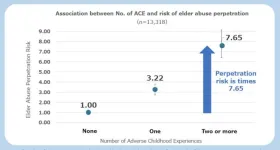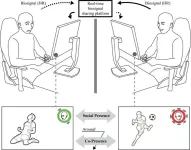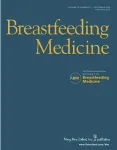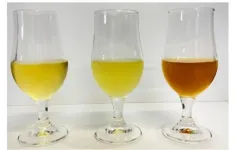(Press-News.org) New research shows the connection between adverse childhood experiences (ACEs), such as physical or emotional abuse, and an increased risk of people growing up to be abusive against older generations. While generational trauma is known to be passed down from parent to child, the study showed that it can also reverberate upwards from parent to older generations. A survey of over 13,000 people in Japan found that about half had one or more ACEs. Of these, 8.5% self-reported committing some form of physical or verbal abuse against people aged over 65. An important contributing factor was the person’s mental and physical health, both of which are known to be affected by ACEs. By better understanding the causes of intergenerational violence, researchers hope to develop guidelines and support to help people break the chain.
You may have heard the old saying “spare the rod, spoil the child.” However, much to the contrary, studies have shown that subjecting children to physical punishment or abuse, emotional abuse, neglect or household dysfunction has long-lasting negative effects on their physical and mental health. Referred to as adverse childhood experiences, this abuse can lead to a self-perpetuating cycle. Later, the children of parents subjected to ACEs are more likely to experience some form of abuse or neglect too.
While ACEs are known to increase the risk of generational violence being passed down, a new study by a team including researchers from the University of Tokyo has shown that this behavior can also travel upwards.
“Our study confirmed that people who had adverse childhood experiences (when aged zero to18), had a higher risk of committing violence and verbal abuse against adults aged 65 and older. The study also showed that psychological factors were the most important contributor,” explained lead author Chie Koga, project assistant professor from the Research Center for Advanced Science and Technology at the University of Tokyo.
The research team studied 13,318 survey responses by women and men (almost evenly split) aged 20 to 64 in Japan. They found that those who reported a higher number of ACEs were more likely to commit physical or verbal abuse against older adults. The ACEs included were: interpersonal loss (parental loss or divorce), family psychopathy (parental mental disease and violence in family), abuse (physical and psychological) and neglect.
Results showed that 8.5% of participants self-reported committing some form of abuse against older adults. Almost half of the respondents had no ACEs, about 36% had one and about 14% had two or more. The risk of perpetuating elder abuse was over three times higher for people with one ACE and almost eight times higher for people with two or more ACEs, compared to those without.
“My hypothesis is that some forms of violence are due mainly to socioenvironmental factors. I believe that violence is the last resort that an individual takes to protect their dignity,” said Koga. “However, especially in Japanese society, the idea that violence is soley the fault of the person who commits it and that they alone are responsible for their own actions is rampant. One reason for this is the enormous lack of research, so this study is one way to advance research in violence epidemiology.”
Other factors which most notably contribute to whether a person with ACEs committed elder abuse included depression, other mental illnesses and how respondents rated their health. Lesser but still relevant factors were living arrangements, marital status, income and whether the person went out at least once a month.
“The results of these studies indicate that the cycle of violence can extend to all vulnerable groups. At the same time, one of the social and environmental risk factors for elder abuse has been newly identified, and the importance of preventing violence has been reemphasized,” said Koga. “However, it’s important to note that not all people with ACEs are repeat offenders of violence. Therefore, we would like to examine the mitigating factors in the future.”
#####
Paper
Chie Koga, Taishi Tsuji, Masamichi Hanazato, Atsushi Nakagomi, Takahiro Tabuchi. Intergenerational Chain of Violence, Adverse Childhood Experiences, and Elder Abuse Perpetration. JAMA Network Open. 27th September 2024.
doi: 10.1001/jamanetworkopen.2024.36150
Useful Links:
RCAST: https://www.rcast.u-tokyo.ac.jp/en/
Funding:
This study was supported by the Japan Society for the Promotion of Science (JSPS) KAKENHI Grant Numbers (21H04856; 20K10467; 20K19633; 20K13721, 24K16531), the JST Grant Number JPMJPF2017, the Health Labor Sciences Research Grant 21HA2016, the grant for 2021–2022 Strategic Research Promotion of Yokohama City University) (No. SK202116) and the research program on “Using Health Metrics to Monitor and Evaluate the Impact of Health Policies,” conducted at the Tokyo Foundation for Policy Research. Dr. Koga had access to all data from the study and is responsible for the completeness of the data and the accuracy of the data analysis.
Competing interests
None
Research Contact:
Project assistant professor Chie Koga
Research Center for Advanced Science and Technology,
The University of Tokyo, 4-6-1 Komaba,
Meguro-ku, Tokyo 153-8904, Japan.
Email: chiekoga@g.ecc.u-tokyo.ac.jp
Press contact:
Mrs. Nicola Burghall (she/her)
Public Relations Group, The University of Tokyo,
7-3-1 Hongo, Bunkyo-ku, Tokyo 113-8654, Japan
press-releases.adm@gs.mail.u-tokyo.ac.jp
About the University of Tokyo
The University of Tokyo is Japan’s leading university and one of the world’s top research universities. The vast research output of some 6,000 researchers is published in the world’s top journals across the arts and sciences. Our vibrant student body of around 15,000 undergraduate and 15,000 graduate students includes over 4,000 international students. Find out more at www.u-tokyo.ac.jp/en/ or follow us on X at @UTokyo_News_en.
END
Breaking the chain of intergenerational violence
People subjected to violence, adverse experiences in childhood are more likely to abuse older generations
2024-09-27
ELSE PRESS RELEASES FROM THIS DATE:
Unraveling the role of macrophages in regulating inflammatory lipids during acute kidney injury
2024-09-27
Tsukuba, Japan—Acute kidney injury (AKI) is associated with a poor prognosis, and no effective treatment has been established to date. Understanding the mechanisms that prevent the progression of AKI is crucial. In AKI, immune cells known as macrophages produce lipid mediators (LMs), which are lipids with significant physiological activity and play a pivotal role in promoting and suppressing inflammation. Thus, elucidating their function is of paramount importance.
In this study, researchers focused ...
Deep underground flooding beneath arima hot springs: A potential trigger for the 1995 Kobe (Hyogo-Ken Nanbu) earthquake
2024-09-27
Tsukuba, Japan—Hot springs frequently contain water that originates from rocks within the Earth's crust. This can be confirmed through isotopic analysis. Arima Hot Springs, located in Kobe, Hyogo Prefecture, Japan, exhibit unique characteristics, including salinity that is more than twice that of seawater, indicating that their water likely originates from the Philippine Sea Plate. However, a direct evidence supporting this connection is lacking.
In this study, researchers confirmed that the isotopic ratios of plate-derived water beneath Arima Hot Springs, as predicted by a numerical model, agreed with those of nonmeteoric water components found ...
Sharing biosignals with online gaming partners to enhance a mutual sense of social presence between complete strangers
2024-09-27
Tsukuba, Japan—Online communication tools are intended to bring people closer together. However, they often fail to sufficiently meet the human need for fulfilling social interactions. What is missing is a sense of social presence, that is, a "sense of being present with another person." This sense of social presence can be felt during mediated interactions, such as when using web conferencing tools or playing video games.
Researchers at the University of Tsukuba have identified a method for augmenting the sense of social presence in online interactions through the sharing of biosignals. Biosignals such as heart rate can ...
ABM releases position statement on breastfeeding in emergency situations
2024-09-27
The Academy of Breastfeeding Medicine (ABM) has released a pioneering position statement that provides comprehensive, global recommendations on protecting, promoting, and supporting breastfeeding in emergency situations. The recommendations are the first of their kind specifically tailored for physicians to support breastfed and non-breastfed infants in emergencies and to serve as an invaluable resource for all emergency relief personnel involved in supporting families with infants during disasters. Click here to read the full position statement, published with Breastfeeding Medicine.
“Breastfeeding ...
Elucidating the mechanism underlying de novo membrane formation during gametogenesis
2024-09-27
Tsukuba, Japan—Sexual reproduction, a common mode of reproduction among numerous species, involves gametogenesis in which offspring are produced through fertilization, conjugation, or mating. In plants and animals, eggs and sperm differentiate from germ cells to form gametes. However, in budding yeast, spores are produced within diploid cells. During this process, de novo membrane structures form within the cytosol, encapsulating the meiotic haploid nuclei to produce spores. Despite this knowledge, the precise mechanism underlying the formation of these nascent membrane structures remains poorly understood.
To ...
Sensors and devices guided by artificial intelligence for personalized pain medicine
2024-09-27
A review paper by scientists at the Indiana University Bloomington summarized recent engineering efforts in developing various sensors and devices for addressing challenges in the personalized treatment of pain.
The new review paper, published on 13 Sept in the journal Cyborg and Bionic Systems, critically examines the role of sensors and devices guided by artificial intelligence (AI) in the field of personalized pain medicine, highlighting their transformative impact on treatment outcomes and patient quality of life.
Pain, a complex and subjective experience, ...
Fruit juice offers a fresh take on kombucha
2024-09-27
Kombucha is a fizzy, tangy drink made by fermenting tea. But brewers are now fermenting other plant-based drinks to explore nutritional properties and flavors. Researchers in ACS Agricultural Science & Technology compared the biochemistry and flavor of kombucha with brews made from apple and passion fruit juices. They found that the apple beverage contained high levels of bioactive compounds called flavonoids and ranked highly among taste testers, signaling its promise as a kombucha alternative.
To make kombucha, brewers ferment sweetened tea with a spongy disk of microbes known as a SCOBY, or symbiotic culture of bacteria and yeast. The ...
Sloth survival under threat due to climate change, new study finds
2024-09-27
A new PeerJ Life & Environment study has revealed that sloths, the famously slow-moving creatures of Central and South America, may face existential threats due to climate change. The research, conducted by scientists studying the metabolic response of sloths to rising temperatures, suggests that the energy limitations of these animals could make survival untenable by the end of the century, particularly for high-altitude populations.
The study, titled "Sloth Metabolism May Make Survival Untenable Under Climate Change Scenarios," investigates how two-fingered sloths (Choloepus hoffmanni), living in both highland and lowland regions, ...
Research sheds light on large-scale cosmic structures
2024-09-27
A new study has mapped out the gravitational “basins of attraction” in the local Universe, offering fresh insights into the large-scale cosmic structures that shape the movement of galaxies. Using advanced data from the Cosmicflows-4 compilation of distances and velocities of roughly 56,000 galaxies, the international research team applied cutting-edge algorithms to identify regions where gravity dominates, such as the Sloan Great Wall and the Shapley Supercluster. This research suggests that our Milky Way most probably resides within the larger Shapley basin, shifting ...
Untapped potential: Study shows how water systems can help accelerate renewable energy adoption
2024-09-27
New Stanford-led research reveals how water systems, from desalination plants to wastewater treatment facilities, could help make renewable energy more affordable and dependable. The study, published Sept. 27 in Nature Water, presents a framework to measure how water systems can adjust their energy use to help balance power grid supply and demand.
“If we’re going to reach net zero, we need demand-side energy solutions, and water systems represent a largely untapped resource,” said study lead author Akshay Rao, an environmental engineering PhD student in the Stanford School of Engineering. ...
LAST 30 PRESS RELEASES:
Why nail-biting, procrastination and other self-sabotaging behaviors are rooted in survival instincts
Regional variations in mechanical properties of porcine leptomeninges
Artificial empathy in therapy and healthcare: advancements in interpersonal interaction technologies
Why some brains switch gears more efficiently than others
UVA’s Jundong Li wins ICDM’S 2025 Tao Li Award for data mining, machine learning
UVA’s low-power, high-performance computer power player Mircea Stan earns National Academy of Inventors fellowship
Not playing by the rules: USU researcher explores filamentous algae dynamics in rivers
Do our body clocks influence our risk of dementia?
Anthropologists offer new evidence of bipedalism in long-debated fossil discovery
Safer receipt paper from wood
Dosage-sensitive genes suggest no whole-genome duplications in ancestral angiosperm
First ancient human herpesvirus genomes document their deep history with humans
Why Some Bacteria Survive Antibiotics and How to Stop Them - New study reveals that bacteria can survive antibiotic treatment through two fundamentally different “shutdown modes”
UCLA study links scar healing to dangerous placenta condition
CHANGE-seq-BE finds off-target changes in the genome from base editors
The Journal of Nuclear Medicine Ahead-of-Print Tip Sheet: January 2, 2026
Delayed or absent first dose of measles, mumps, and rubella vaccination
Trends in US preterm birth rates by household income and race and ethnicity
Study identifies potential biomarker linked to progression and brain inflammation in multiple sclerosis
Many mothers in Norway do not show up for postnatal check-ups
Researchers want to find out why quick clay is so unstable
Superradiant spins show teamwork at the quantum scale
Cleveland Clinic Research links tumor bacteria to immunotherapy resistance in head and neck cancer
First Editorial of 2026: Resisting AI slop
Joint ground- and space-based observations reveal Saturn-mass rogue planet
Inheritable genetic variant offers protection against blood cancer risk and progression
Pigs settled Pacific islands alongside early human voyagers
A Coral reef’s daily pulse reshapes microbes in surrounding waters
EAST Tokamak experiments exceed plasma density limit, offering new approach to fusion ignition
Groundbreaking discovery reveals Africa’s oldest cremation pyre and complex ritual practices
[Press-News.org] Breaking the chain of intergenerational violencePeople subjected to violence, adverse experiences in childhood are more likely to abuse older generations






